Holzindustrie Schweighofer
Holzindustrie Schweighofer is part of the Schweighofer Group and has its roots in an Austrian family business with more than 400 years of experience in woodworking. Today's key business units are wood industry, forestry, bioenergy production and real estate.
 | |
| LLC | |
| Industry | Wood, Manufacturing |
| Founded | 2002 (in the present structure) |
| Headquarters | Vienna, Austria (Schweighofer Group, Holding) Bucharest, Romania (Holzindustrie Schweighofer) |
Key people | Gerald Schweighofer, Frank Aigner, Jürgen Bergner, Christian Hörburger, Martin Louda |
| Products | timber, construction wood, glue lam products, blockboards, concrete formwork panels, pellets, briquettes, DIY- wood products |
| Revenue | appr. 520 Mio Euro in wood business (2016) |
Number of employees | more than 3,100 (only wood business, 2017); Group: 3.500 (2017) [1] |
| Website | http://www.schweighofer.at/ |
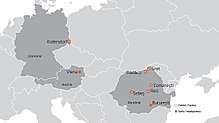
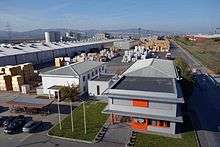

Schweighofer has been active in Romania since 2002 and opened its first sawmill in 2003. Nowadays the company is leading in European woodworking business, employs more than 2.500 people in four production sites in Romania and is also active in the Czech Republic, Bulgaria, Germany and Ukraine.[2] The company owns three saw mills in Romania in Reci, Rădăuţi and Sebeş, of which the latter has been accused to deal in illegally logged woods.[3][4]
History
17th to 20th century
For the Schweighofer family wood working has a long tradition, which was handed over from generation to generation. The first related remark in official documents was made in the year 1642. The actual success story started in 1956, when Franz and Maria Schweighofer took over the family owned saw mill in Brand, Lower Austria. At that time the annual mill capacity was about 1.000 m³.
Gerald Schweighofer started his career in the company in 1975. Due to his innovative spirit and his readiness to assume a risk, he opened the worldwide unique profiling line for small diameter logs at the headquarters in Brand/Austria, in 1977. Holzindustrie Schweighofer opened Europe's largest saw mill (at that time - 1984) in Ybbs an der Donau/Austria.
After take over and enlargement the saw mill in Sollenau/Austria started processing in 1991. Holzindustrie Schweighofer took over the biggest and most modern saw mill in Zdirec in the Czech Republic (1996).
After taking over the saw mill Bad St. Leonhard/Austria, in 1997, and another saw mill in Plana/Czech Republic, Holzindustrie Schweighofer reached a total sawing capacity of 3 Mio. m³ in six different mills. Moreover, the glue lam mill Lamco was built in cooperation with the Japanese company Maiken and the Schweighofer Privatstiftung was founded.
Holzindustrie Schweighofer merged with Enso Timber, in 1998, and became the third largest saw milling company in the world. The Schweighofer family sold its shares and hence all sawmills in Austria and the Czech Republic to Stora Enso Timber (2001).
In 2011, the Schweighofer Group bought the M-real Hallein GmbH in Austria. In September 2017, the Schweighofer Group sold the plant in Hallein to TowerBrook Capital Partners, which intends to keep the pulp dissolving mill in full operations. Schweighofer explained this move with increasing its focus on its core business of sawmilling.[5]
History in Romania
- In 2003 Holzindustrie Schweighofer started production in the new and modern sawmill in Sebeş, Romania[6]
- In 2007 a 4 stars hotel was opened in Rădăuți - The Gerald's Hotel[7]
- In 2008 after finalization the second saw mill in Rădăuți started operations[8]
- In 2009 the Romanian Swedwood manufactory was taken over in Siret, close (12 km) to the second mill in Rădăuți. After the modernization and enlargement of the factory solid wood panels have been produced there[9]
- Since 2010 Holzindustrie Schweighofer BACO produces blockboards and concrete formwork panels in the previous Finnforest factory in Comăneşti[10]
- In 2015 evidence emerged of widespread destruction of virgin forests by Holzindustrie Schweighofer suppliers. It was alleged that Holzindustrie Schweighofer was fully aware that the wood they were sourcing was illegally logged.[11]
- In 2018 a Romanian NGO released a report which alleged that Holzindustrie Schweighofer was continuing to knowingly source illegally logged timber.[12]
Production units
Holzindustrie Schweighofer operates at present 5 production units in Romania: Three sawmills in Sebeș, Rădăuți and Reci (county Covasna) and two factories for blockboard and glue lam products. In 2015 the company bought another sawmill in Kodersdorf in Germany from the Klausner Group. In Kolomyia (Ukraine) the infrastructure for another sawmill is being prepared.[13]
Sawmill Sebeș
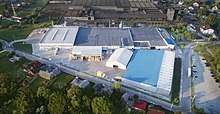
thumb|Blockboard factory in Comănești, Romania.


The sawmill in Sebeș (700 employees) was Schweighofer's first factory in Romania and started operations in 2003. According to the company, the annual cutting capacity is 1,45 million m³.[14][15]
Sawmill Rădăuți
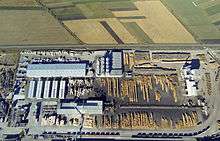
The second Schweighofer factory in Romania (600 employees) was opened in 2008. The annual cutting capacity amounts to 1.45 million m³. One of the main products manufactured in Rădăuți are laminated timber components (post and beams) made from pine, which are mainly destined for the Japanese market.[16][17]
Sawmill Reci
The sawmill in Reci, Covasna County, is Holzindustrie Schweighofer's newest production unit. Following a 150 million euro investment,[18] the factory commenced operations in August, 2015. The production unit spans over 70 hectares[19] and has a cutting capacity of 800.000 m3 round wood.[20] The factory employs 650.[21][22]
Sawmill Kodersdorf
In 2015 the Schweighofer Group took over the sawmill in Kodersdorf (Germany) from the Klausner Group, which will do business under the name of Holzindustrie Schweighofer GmbH. Operations were transferred in October 2015. All employees were hired by Holzindustrie Schweighofer. The factory processes spruce and pine. Its annual cutting capacity is 1.2 million m³ of logs.[23][24]
Edge glued panels factory Siret

The edge glued panels factory in Siret was taken over from the IKEA-subsidiary company Swedwood in 2009. 260 employees are working there. 70.000 m³ of finished products and 20.000 t of briquettes are produced annually.[25]
Blockboard factory Comănești
In 2010 Schweighofer took over the blockboard production factory from Finnforest in Comănești. With 750 employees and its annual production volume (135.000 m³ blockboards) it is the world's largest blockboard production in one location.[26]
Sawmill Kolomyia (being prepared)
In Kolomyia (Ukraine) another sawmill is planned, at present the infrastructure is being prepared. Investment: 50 Mil. Euro.[27]
Business areas
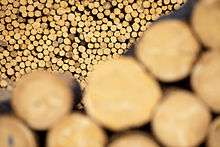
The core areas of business of Schweighofer Group are:
- Production and processing of wood products
- Production of bioenergy
- Trade of wood products
- Forestry
- Real estate
- Hotel
Wood industry
The key business of Schweighofer Group is the wood industry with factories in Romania and Germany. Besides classic sawmills, Holzindustrie Schweighofer also runs two wood working factories. Main products are timber, construction and packaging timber, planed (semi)finished timber, glue lam products, finger jointed products, blockboards, concrete formwork panels, pellets and briquettes.[28]
Bioenergy production
Schweighofer Group runs 4 bioenergy power plants in Romania. In these CHP (cogeneration heat and power plants) barks, wood shavings and wood chips are used for the generation of energy. Schweighofer is also share holder of the biomass power plant in Suceava, Romania.
Timber trade
Schweighofer holds 25.1% of the shares of the wood trading company DABG.[29] Timber trading activities – focussing on North Africa and Middle East - are done by this subsidiary company.
Viscose pulp production
Since 2013 Schweighofer Fiber (Hallein, Salzburg, Austria) has been producing high quality viscose pulp, that is used for the production of e. g. textiles. 240 employees produce 150.000 tons of viscose pulp (for viscose fiber and nitrocellulose).
The production of viskose pulp influenced the economic location Hallein. In 2015 the pulp factory celebrated its 125th anniversary. Besides pulp production the company today is into bio-energy and long-distance heating as well. The location is being modernised. An example is the new automatic loading terminal, which is used by traders e. g. of pellets since May 2015. The storage capacity is 1.000t and the annual handling capacity is 40.000t of pellets.
In 2017, the Schweighofer Group sold its plant in Hallein to TowerBrook Capital Partners.[5]
Forestry
The Schweighofer owned forests in the Czech Republic and Romania are managed by qualified forestry experts according to the principles of near-natural and sustainable forestry. In Romania however Schweighofer is mentioned in attacking Retezat National Park.[30] Contrary to this statement, Holzindustrie Schweighofer claims it has taken concrete steps to protect old-growth forests, including in Campusel (Retezat Mountains).[31] In March 2018, the Schweighofer Group sold its Romanian forests to the Swedish GreenGold Group.[32]
Real estate
Schweighofer Group develops and runs real estate projects in inner cities of Austria and Canada.
The Gerald’s Hotel
Opened in 2007 The Gerald's Hotel is one of the most modern hotels in Northern Romania and offers high class amenities and services to international travellers. The Gerald's Hotel (4 stars) has 99 double rooms and it is located close to the municipal park and the City Hall of Rădăuți.
Schweighofer Prize
The Schweighofer Prize[33] awards innovative ideas, technologies, products and services along value chain in order to strengthen the competitiveness of the European Forest Based Sector. It has been presented every second year since 2003. It is endowed with a total prize money of €300,000 before tax. The prize is divided into one Main Prize and several Innovation Prizes.
- Prize winner 2017: Hermann Blumer (Switzerland) & Shigeru Ban (Japan)
- Prize winner 2015: Erich Wiesner, CEO of the Wiehag Group
- Prize winner 2013: Dott. Ing. Federico Giudiceandrea, MiCROTEC GmbH, Brixen, Italy
- Prize winner 2011: Dieter Siempelcamp, Siempelcamp GmbH & Co. KG, Krefeld, Germany
- Prize winner 2009: Prof. Dr. Gerd Wegener, Professor für Holztechnologie, University of Technology, Munich, Germany
- Prize winner 2007: Prof. Matti Kairi, Professor, Technical University of Helsinki, Finnland
- Prize winner 2005: Prof. Julius K. Natterer, Director of Laboratory for Timber Constructions (IBOIS), ETH Lausanne, Switzerland
- Prize winner 2003: Hans Hundegger, Otto Martin enterprises, Allgäu, Germany
The Schweighofer prize was ended after the 2017 award ceremony.[34]
Controversy
On May 22, 2014 a public letter from Ukrainian ecological organization Kyiv Ecology and Culture Center appeared indicating that construction of wood processing factory in Ivano-Frankivsk region of Ukraine would require 500 000 tons of gravel to be excavated from local river beds, thus threatening Carpathian ecology.[35] Ecologists have never received any response from company officials. The Environmental Investigation Agency (EIA) in 2015, releases their investigation of illegal logging in Romania. The report implicates Schweighofer as a major promoter and recipient of the destruction of Carpathian old growth forests.[36] A comprehensive documentary released by Organized Crime and Corruption Reporting Project and RISE Project follows the illegal harvested wood in Romania.
On Feb 17, 2017, Forest Stewardship Council has disassociated itself from the company because of the company involvement in the purchasing and trading of illegally harvested timber in Romania and that this is having a negative impact on the country's natural protected areas.[37]
In the summer of 2017, FSC launched a stakeholder process in Romania, which sets out the conditions under which Holzindustrie Schweighofer may return to FSC.
In response to criticism, the company has presented an action plan for a sustainable timber industry in Romania. Its core measure is the self-developed GPS tracking system "Timflow". Holzindustrie Schweighofer records the route of all trucks that deliver saw logs to its sawmills. This data, together with photos of the loaded trucks, is publicly available at www.timflow.com. Holzindustrie Schweighofer wants to prove with this data that it does not receive wood of illegal origin and also adheres to its voluntary commitment not to accept wood from national parks.[38]
An investigation in 2018 by Environmental Investigation Agency found that the company was continuing to buy wood from third party suppliers which comes from Romania's national parks.[39] Holzindustrie Schweighofer publicly, strongly rejected these allegations. Moreover, the company has made a voluntary commitment not to process any wood originating from national parks. This commitment also includes areas of national parks (“buffer zones”) where harvesting is explicitly permitted by law.[40]
Further reading
- Leutgeb, Rupert: Franz Schweighofer. 80 de ani de aur. Nord Forest Edition, Viena 2008
External links
- Holzindustrie Schweighofer: www.schweighofer.at
References
- "Schweighofer Website, About us". November 3, 2015.
- https://www.schweighofer.at/en/production-sites.html
- Klawitter, Nils (May 8, 2015). "Clear-Cutting Romania: Logging Threatens One of Europe's Last Virgin Forests". Spiegel Online.
- "Public Search". info.fsc.org. Retrieved 2016-02-10.
- "Detail". www.schweighofer.at. Retrieved 2017-12-14.
- http://www.schweighofer.at/de/produktionsstandorte/sebes.html
- http://www.geraldshotel.com/
- http://www.schweighofer.at/de/manufacturing-units/radauti.html
- http://www.schweighofer.at/de/produktionsstandorte/siret.html
- http://www.schweighofer.at/en/manufacturing-units/comanesti.html
- Vaughan, Adam. "Major Austrian timber firm accused of illegal logging in Romania". www.theguardian.com. The Guardian. Retrieved 13 December 2019.
- Ionut Iordachescu, Mihaela Rodina and. "Romania's forests under mounting threat—along with rangers". phys.org. Science X Network.
- "Holzindustrie Schweighofer – Production Sites". Retrieved 2015-11-03.
- "Holzindustrie Schweighofer – Our Plant at Sebes". Retrieved 2015-11-03.
- "Sebeș". www.schweighofer.at. Retrieved 2017-12-14.
- "Holzindustrie Schweighofer – Our Plant at Radauti". Retrieved 2015-11-03.
- "Rădăuți". www.schweighofer.at. Retrieved 2017-12-14.
- "How does Covasna county economy look like, where only one company managed to cross the 100 million euro threshold". Ziarul Financiar, 7 August 2014.
- "Holzindustrie Schweighofer commences operations in its newest sawmill in Reci". Bursa,27 October 2015.
- "Holzindustrie Schweighofer commences operations in its newest sawmill in Reci, a 150 million euro investment". Business Magazin, 27 October 2015.
- "Schweighofer opens a new sawmill in Romania". Mediafax, 27 October 2015.
- "Reci". www.schweighofer.at. Retrieved 2017-12-14.
- "Holzindustrie Schweighofer – Our Factory at Kodersdorf". Retrieved 2015-11-03.
- "Kodersdorf". www.schweighofer.at. Retrieved 2017-12-14.
- "Siret". www.schweighofer.at. Retrieved 2017-12-14.
- "Holzindustrie Schweighofer – Our Plant at Comanesti". Retrieved 2015-11-03.
- "Schweighofer to build a sawmill in Ukraine". Retrieved 2014-09-24.
- "Holzindustrie Schweighofer – Products". Retrieved 2015-11-03.
- http://www.dabg.at/
- gandeste.org
- "Detail". www.schweighofer.at. Retrieved 2017-12-14.
- "Schweighofer Group quits its Romanian forest investments". Retrieved 2018-04-23.
- http://www.schweighofer-prize.org/prize.en.html
- "Schweighofer Prize". www.schweighofer.at. Retrieved 2018-10-09.
- http://gazeta.ua/ru/articles/economics/_stroitelstvo-fabriki-v-ivanofrankovskoj-oblasti-grozit-katastrofoj-vsemu-regionu-ekologi/559147?mobile=true
- https://s3.amazonaws.com/environmental-investigation-agency/posts/documents/000/000/319/original/Stealing_the_Last_Forest.pdf?1468592842
- FSC, International. "WWF GERMANY VS. HOLZINDUSTRIE SCHWEIGHOFER". FSC International. Retrieved 17 February 2017.
- m.b.H., STANDARD Verlagsgesellschaft. "Holzriese Schweighofer will zurück zu den Guten". derStandard.at. Retrieved 2017-12-14.
- Insider, Romania (2018-07-18). "EIA: Biggest timber producer in Romania continues to use logs from national parks". Romania Insider. Retrieved 2018-07-18.
- "Holzindustrie Schweighofer: Constant improvement of robust due diligence system for wood deliveries in Romania – offer of cooperation to NGOs". Retrieved 2018-07-20.